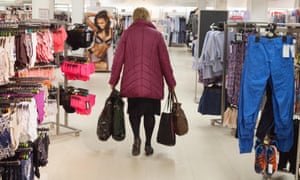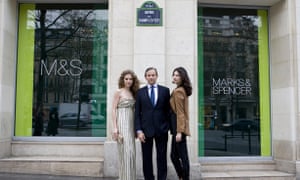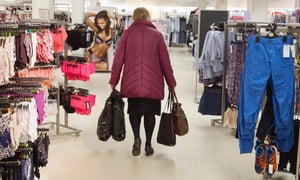
Marks & Spencer is shutting 30 UK stores and converting 45 more into food-only shops as part of a major business overhaul that will slash the amount of shopfloor space devoted to its ailing clothing ranges.
The retailer’s new chief executive, Steve Rowe, said more than 100 UK stores were in the firing line as part of a wider shakeup designed to end a long-running slump in clothing sales and devote more space to its more successful food business. He outlined plans to open 200 new Simply Food outlets.
M&S refused to identify which 30 “full-line” stores – which sell clothing, homewares and food – are to close or identify the 45 outlets that will be converted into food stores. The chain has 304 full-line stores and the closures and conversions will take five years to complete.
The retailer is also looking to relocate underperforming stores. Overall, the changes will mean a reduction of 10% in the floorspace devoted to racks of skirts, jumpers and trousers, with the plan expected to cost £150m over three years.
The turnaround plan outlined by Rowe also includes the closure of 53 loss-making overseas stores in 10 countries. They include 10 stores in China, seven in France and others in Belgium and Hungary, resulting in 2,100 job losses. Only company-owned stores in Ireland, Hong Kong and the Czech Republic will be spared.
The embattled retailer intends to put clothing and food on an equal footing with same amount of selling space devoted to both sides of the business. Currently two-thirds of its floor space is given over to racks of clothing and homewares.
Rowe, who began his retail career aged 15 as a Saturday boy at M&S’s Croydon store in south London and took over as chief executive six months ago, insisted the decision to close stores and reduce the space given over to clothing was not an admission of defeat.
“This is not about cutting jobs, it’s about making sure we’ve got the right estate for future shopping habits,” he said.
Earlier this year, he announced 500 job cuts at the group’s head office in London and a plan to shift another 400 jobs out of the capital.
The M&S veteran is seeking to revive the fortunes of the 132-year-old retailer which has seen profits go backwards in recent years. His biggest job is stopping the rot in its clothing business which has now in its fifth consecutive year of falling sales. M&S believes the growth of online fashion shopping means it can devote more store space to food without losing sales. About 17% of M&S’s clothing sales are currently made online, a figure that is expected to grow.
Rowe is also axing the chain’s Indigo, Collezione and North Coast labels to focus on brands that are “most relevant to our customers” including Autograph, Per Una and Blue Harbour.
These are tough decisions, but vital to building a future M&S that is simpler, more relevant, multichannel and focused on delivering sustainable returns,” said Rowe.
The plan was not well received by investors; shares finished the day as the biggest faller in the FTSE 100 – down more than 5% as analysts complained that Rowe’s plan to revive M&S was not radical enough. “Being such a large company, it is going to take some time to turn M&S round even if all goes according to plan,” said Haitong analyst Tony Shiret. “We think that it should have gone further in its UK clothing space closure.”
M&S’s decision to retreat from the high street will be a blow for some towns, where it is a main destination store, especially following the demise of BHS. But as more purchases are made online, stores in smaller or less attractive town centres and shopping centres are finding life difficult.
“The closure of the local M&S will have a psychological effect and feel like another nail in the coffin for that town’s high street,” said Local Data Company analyst Matthew Hopkinson. Hopkinson points to places such as Swindon and Stockton-on-Tees where shoppers have been drawn away from the high street by out-of-town retail parks.
M&S has been battered by low-cost rivals such as H&M, Zara and Primark and shoppers are increasingly spending their spare cash on leisure activities, rather than buying new clothes. The turnaround plan was unveiled as the retailer reported a 19% fall in underlying profits to £231m in the six months to 1 October.
To win back shoppers, Rowe has already cut clothing prices and promised to pay more attention to its most loyal group of shoppers – fiftysomething women he has dubbed “Mrs M&S”. He said changes he had already made in the clothing business were going down well. “The initial feedback we’ve had from customers has been good,” he said. “We’ve improved the fit on many garments and, for the first time in a number of years, we’ve grown full-price market share.”
Rowe has promised a less slavish pursuit of catwalk trends after being criticised for failing to meet the needs of its middle-aged customer base.

His new strategy is an about turn from that of his predecessor Marc Bolland, who believed the retailer could be a global brand and reopened stores in France after a decade-long absence.
“We have made mistakes in the past and we are taking action to correct some of these,” said Rowe, who revealed M&S would continue to expand overseas using a franchise model. The mistakes are expensive ones – it will cost up to £200m to shut loss-making stores in European markets such as France, Belgium and the Netherlands as well as outposts in China.
[Source:-The Guardian]






